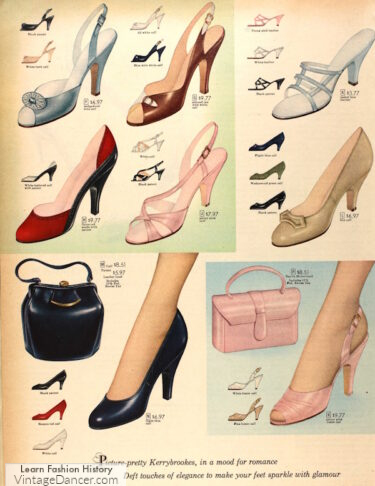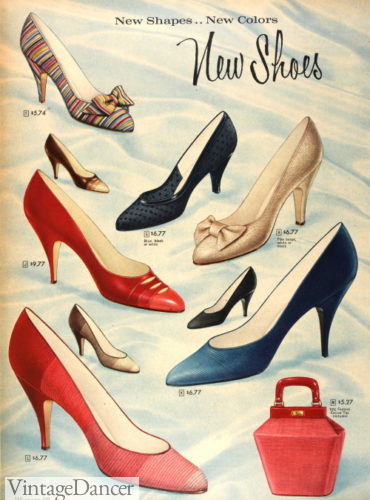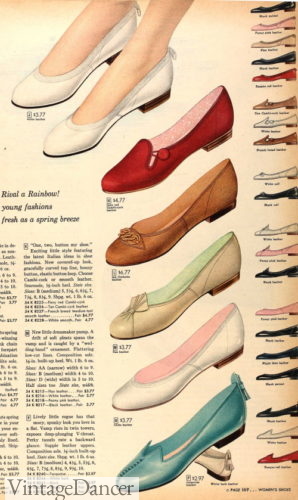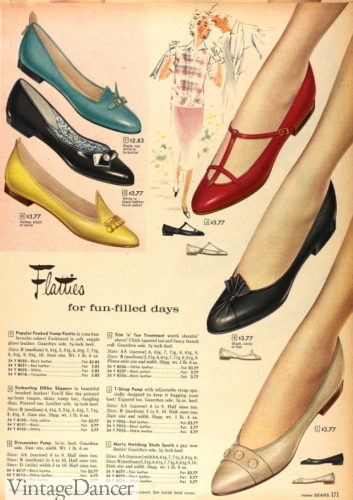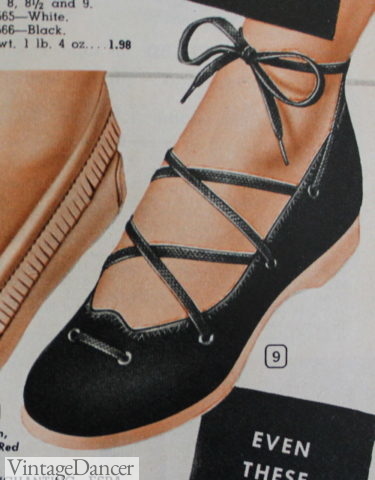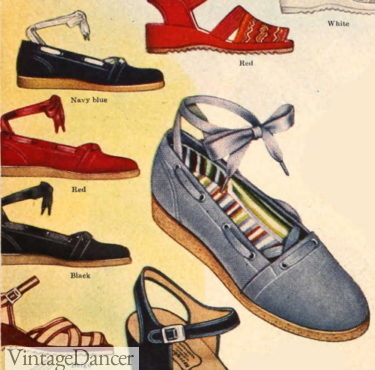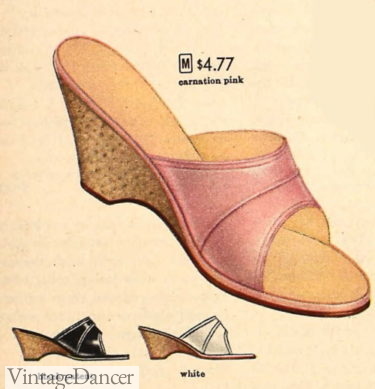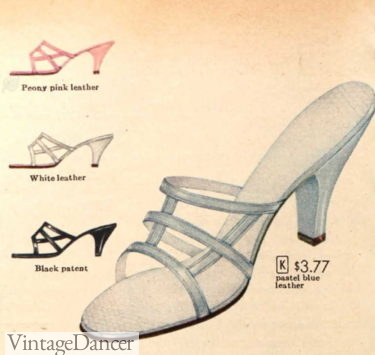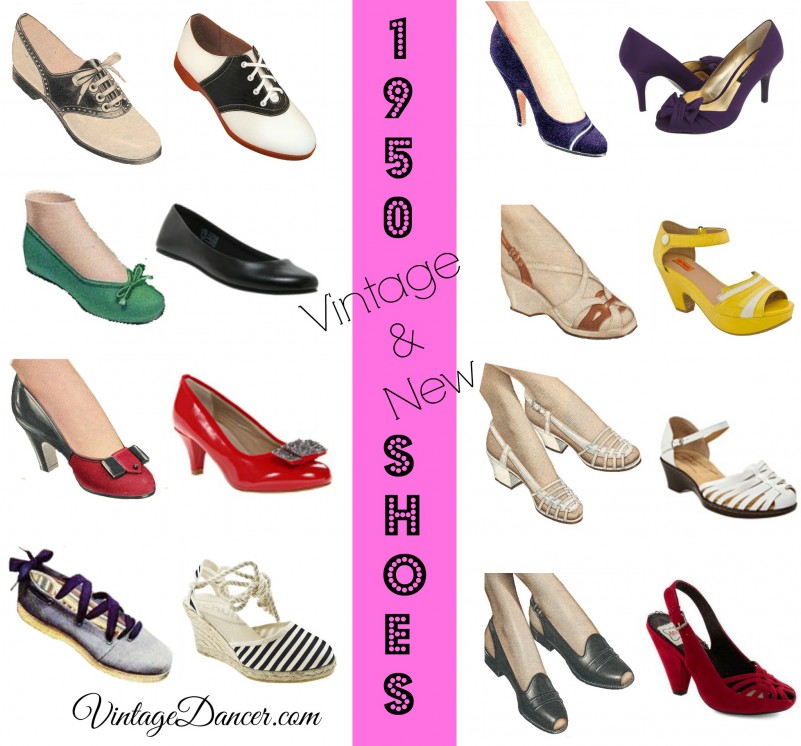
1950s Shoes: Vintage and New Shoes. Shop 1950s style shoes here.
Fashion in the 1950s brought the world out of the conservative war years and into the dazzling ’50s. Dresses were bigger, accessories richer, hairstyles taller, and shoes.…well, plainer. With so much new emphasis on the rest of women’s fashion, 1950s shoe styles became understated accessories.
What kind of shoes did they wear in 1950? Instead of bold patterns and piles of fancy adornments, 1950s shoes were classy single color pumps, flats, wedgies, sandals and loafers.
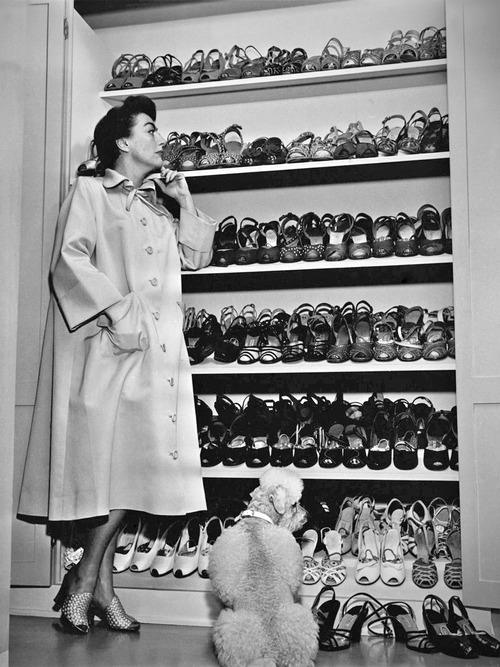
A Plethora of 1950s Shoes
Black and brown 50s shoes were the main choices for day wear, while brighter colors were acceptable for summer sportswear or house slippers. Shoes also coordinated perfectly with an outfit’s accessories by matching purses, gloves, belts, and even jewelry perfectly.
The 1950s shoe styles were varied, but almost all came down to fitting into one of these popular silhouettes. Learn the history of women’s 1950s and where to buy them today.
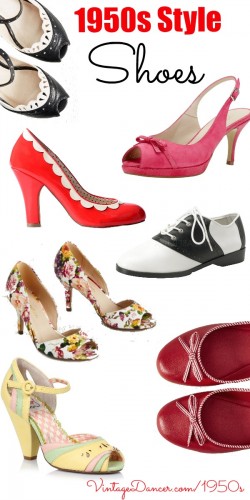
1950s style shoes. Shop 1950s style shoes.
1950s Pumps and Heels
What were shoes made of in the 1950s? 1950s shoes were made of a soft leather or reptile skin. Suede and some fabric materials, like cotton, velvet or mesh, were used as well.
Toe shapes varied over the years- some very round, some very narrow almond shapes, and most were somewhere in-between.
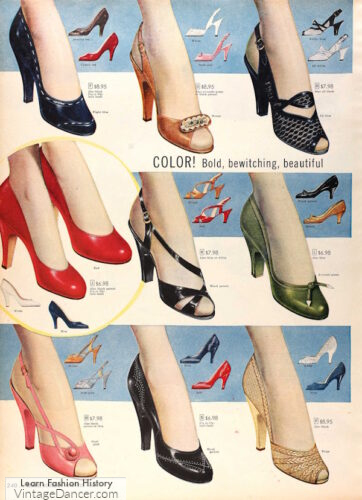
1955 heels in bold colors
How high were heels in the 50s? Low heels averaged 1-2 inches while high heels were between 2 and 3 inches. Illustrations in ads and catalogs always make heels look taller then in real life.
In the 1950s, the stiletto heeled opera, court, and pump shoes were all the rage. At an extreme, they were very tall with 4-inch spiked ultra thin heels. Early on, the heels ended in a small metal cap that left dents in soft wood floors, requiring some museum and court houses to forbid stiletto shoes.
The stiletto featured tall arches with a V shaped cutaway from the shoe sides. Red was the most bold and in-demand color for formalwear. They were impractical and mostly only worn for very special occasions, short durations, and by fashion models.
- 1957 high heels
- 1959 stiletto’s heels
The winklepicker was a extreme version of the already extreme opera pump. With its sharp pointy toe and high thin heel, it was trendy in the late 1950s for formal and even semi-formal at-home wear.
Thicker but still shapely tall heels continued to be worn with fancy dresses. Some heels had pretty all- over designs carved, painted or printed onto them, while others had decorations around the edges.
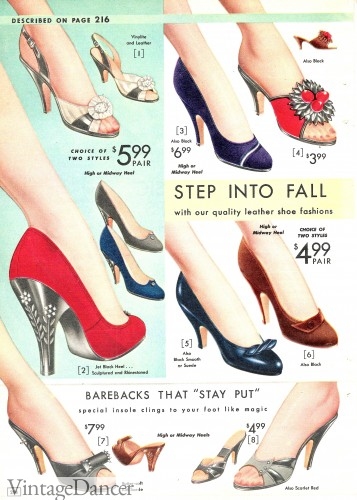
1957 heel shoes with fancy decorations
The very strappy tall heel shoes were another ideal shoe for evening wear. Ultra thin T-straps, slingbacks, and ankle straps all provided just enough coverage to keep the shoe on but ultimately made the foot look bare. Especially in nude colors and sometimes clear plastics, they complimented dreamy party dresses elegantly.
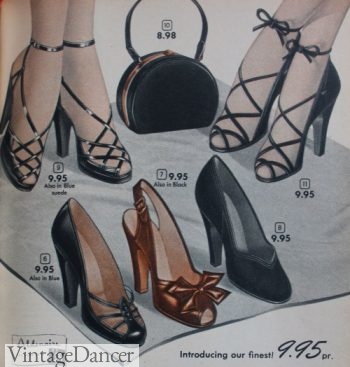
1951 Strappy heels
Lucile Ball wore tall chunky ankle strap shoes through most of the early 1950s. These were a carry over style from the 1940s worn by many pinup girls. While many shoes retained the thicker heels of the war years, especially for working classes, most fashion followers preferred the smaller narrow heeled shoes as a rebellion from the masculine ’40s.
Unlike the 1940s famous peep toe sandals, the 1950s version was far more sexy. Toes were fully exposed and straps were very thin.
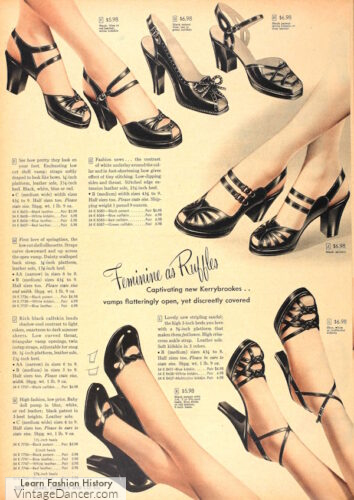
1951 heels, 1.5 to 2 inches
For evening shoes, jewel tone colors, especially glittery gold and dark silver, were fashionable as well as black. In the late 50s the strapless heel, called mules, were popular. The new no-seam stockings made them even more glamorous to wear.
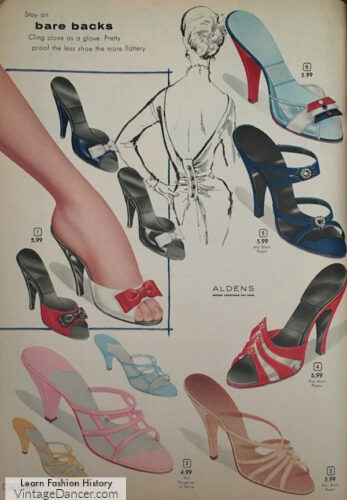
1958 mule heel evening shoes
Evening sandals showed off the most foot skin and had the thinnest heels. Most daywear sandals had lower chunky heels and a medium thick ankle strap around the heel, called a slingback. Slingback straps were found on pumps, wedges, and slip-on casual shoes, too. The style assured women their feet would not slip out of the shoes – a dangerous and embarrassing accident.
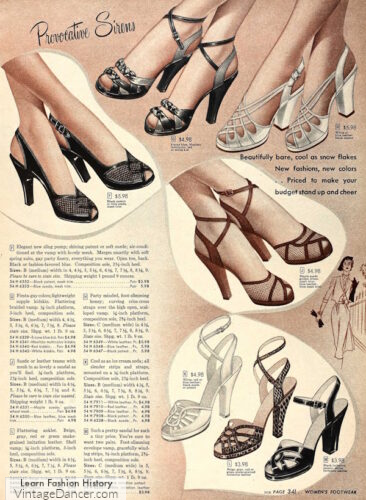
1952 ankle strap heels with 2-3 inch heels
After trying to balance on tall heels, most 1950s women regained their senses and accepted low but still thin kitten heel shoes. These classic dress shoes were safer to walk in, yet still remained elegant and classy.
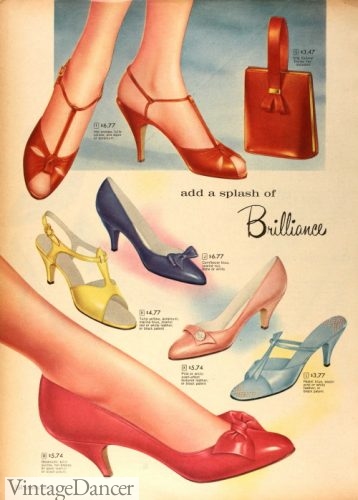
1959 short heels
For everyday wear, around the house or running errands, a thicker low to mid heeled pump (1-2 inches) was the best choice. Black was the color that went with the most outfits, so every woman had at least one pair. A single strap low heel, called Mary Janes today, were a good option.
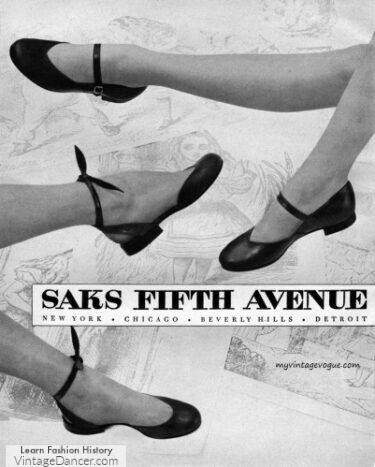
1951 single strap or ankle strap low heel shoes
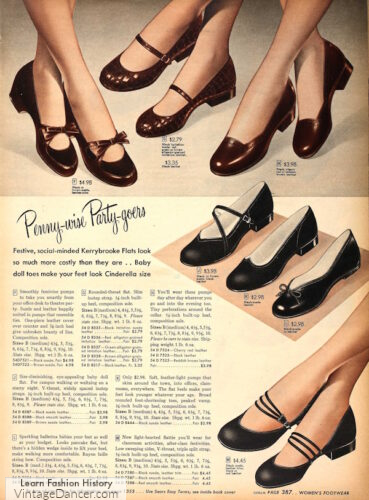
1951 low heel daytime or party shoes
One style of day pumps were called Baby Dolls. They featured very round toes that resembled a doll’s shoes. They came in many fun colors during the spring and summer, with cute accent decorations on the trim or an ornament on the vamp.
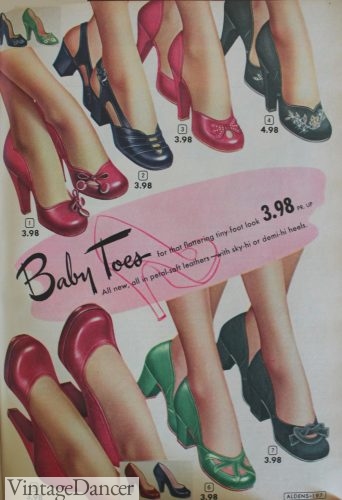
1953 “Baby Toes” Shoes
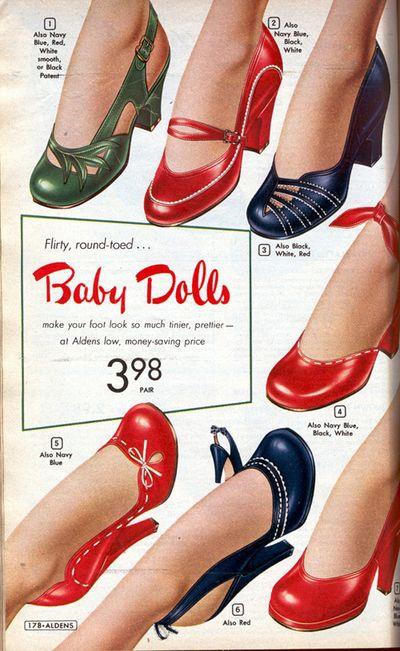
1950s “Baby Doll” Pumps
The walking oxford that had been women’s staple shoe design since the 1910s was no longer fashionable in the 1950s. But they did not disappear. Older women and working women (nurses, maids, hairdressers) continued to wear these common sense heels with all outfits.
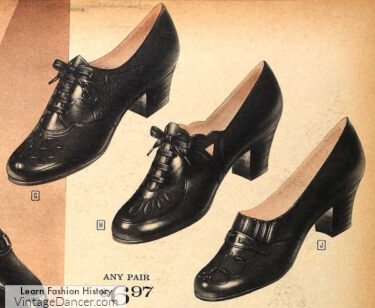
1959 oxford shoes
1950s Ballet Flats
Another 1950s shoe style called flatties, or flats in today’s lingo, were popular as house shoes. They were sometimes worn with pants outside of the home for casual occasions.
Teenagers wore flats shoes as often as saddle shoes when Audrey Hepburn declared them her favorites. Ballet flats featured very small heels of 1/2 inch but were the most trendy when they had no heels at all– just flat, flat, flat!
Black was the most common color of flats with a thin bow on the top. Other colors often matched an accessory such as a belt, scarf, purse, or hair ornament.
- 1957 flats
- 1959 flats
Of all the flatties brands, Capezio was the cream of the crop. They were luxury for those that could afford them, but oh so divine. They had no heels, very low profile sides, deep cut on the toes to reveal toe cleavage, and had sharp pointed toe tips. They exuded sexiness like no other flat could!
Learn more about vintage flats shoes and history.
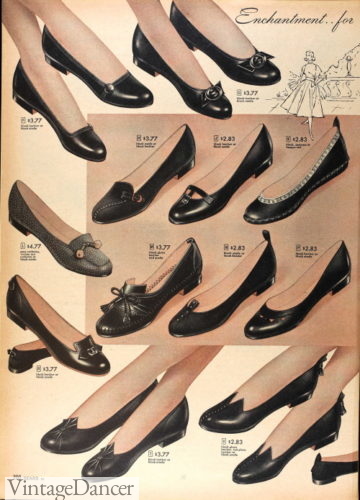
1957 black flats
Capezio and Bernardo both created a lace up flat called ghillies. It was a sister to the espadrille shoe but looked more like a cross between a man’s Oxford and a ballet shoe.
The long ghillie laces provided endless amusement in devising new ways to tie the straps. At the back of the ankle was the best way to tie 1950s espadrilles, while wrapping up and around the leg was the vogue thing to do with ghillies. Many movies showcased women dancing in ghillies (see if you can spot them next time you watch a 1950s musical).
- 1953 ghillies
- 1954 ghillies
- 1951 ghillies
1950s Wedges
Beside the peep toe, the iconic shoe of the 1940s was the wedge or wedgie shoe. They were, however, equally popular in the 1950s.
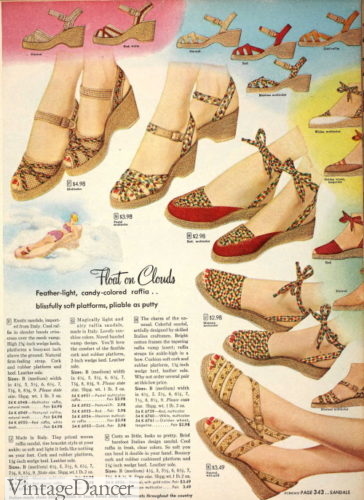
1953 wedge platform sandals
Wedges naturally retained the chunky sturdy shape and gave a nice lift to the heel (sexy!). Toe openings were bigger in the 1950s, and wedge heels were a bit taller and curved inward for a slightly more delicate look.
Most came with a .5 to 2 inch platform sole as well, giving extra height to the wearer. They were and still are a style that screams “vintage” or “retro” shoes!
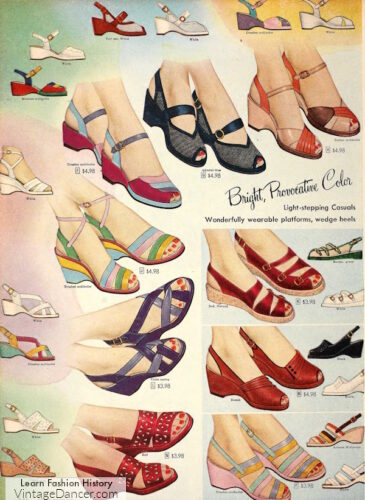
1953 platform wedge shoes
1950s Slippers and Mules
Only in extreme summer heat did women go without stockings. Wearing stockings with sandals was a must. Wearing them with strapless mules made for a rather slippery experience.
- 1957 pink wedge mules
- 1957 strappy sandal mules
In 1954, a solution called “Spring-O-Lators” featured a leather and elastic band down the inside of the mule to push the foot forward and keep the shoe on. Finally, women could wear mules for evening wear or at home as dainty bedroom slippers (not practical enough for house slippers, bedroom slippers were only worn with sexy lingerie as an enticement for husbands).
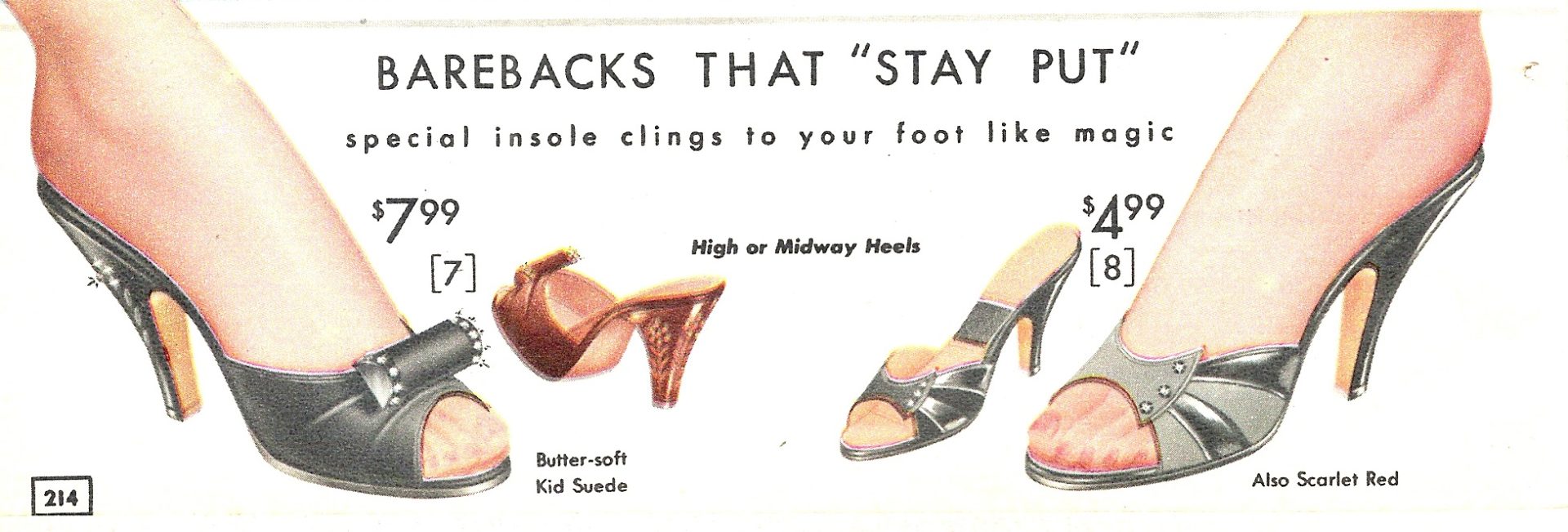
1957 Spring-o-lator mules
For summer wear, thin heeled mule shoes and slingback sandals were in vogue. If they featured any extra adornment, it came in the form of a thin, flat bow across the toe. Straps were wide, and heels either very thin or more commonly thick and rounded.
1950s Saddle Shoes
Teenagers and house wives wore saddle shoes. These were black and white Oxford shoes most associated with teenage girls in felt poodle skirts. They were usually worn with a pair of bobby socks— white socks rolled or folded down 2 or 3 times.
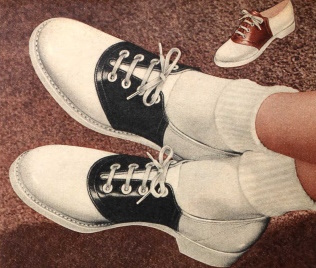
1956 saddle shoes, white soles, white cuff bobby socks
The soles and heels of saddle shoes were black along with the center panel. White shoes and heels had to kept in pristine condition. Girls would clean and shine their shoes nightly and buy new ones as soon as they began to show signs of wear.
Learn about the history of saddle shoes and shop black and white saddle shoes here.
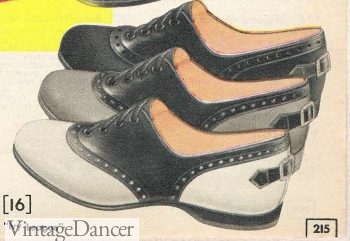
1957 Saddle Shoes with buckle strap
White “bucks”, or nubucks, were another style of Oxford shoe for teens and school girls. They had to be kept perfectly white all the time. Small “bunny bags” of chalk powder were included with each white buck shoe so girls could powder them on breaks.
Another white shoe was the clunky Joyce, which resembled a nurse’s shoes or senior orthopedic shoes today. They also had to be kept perfectly white at all times. Bleaching laces, polishing leather, and washing soles were all part of the nightly routine.
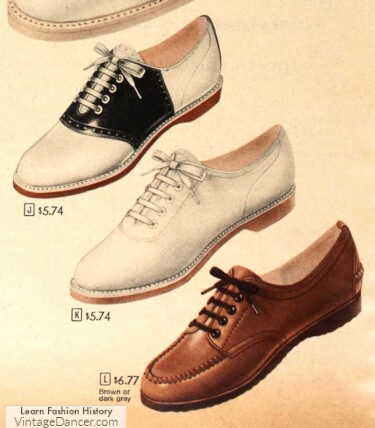
1959 saddle oxford, white bucks, brown moc oxfords
Some teens still wore Mary Jane shoes — a single strap Oxford shoe. They were a young girl’s shoe that to teens meant you were too young to know how to keep your shoes on. Graduating to a strapless shoe meant growing up.
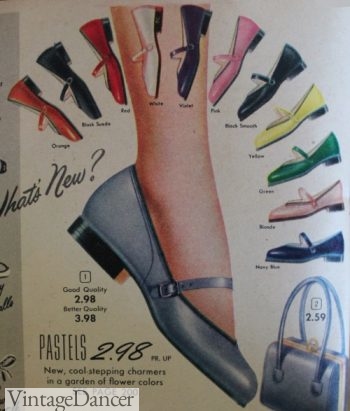
1953 Mary Jane Shoes with Low Heels
There was a trend for the T-strap shoes starting in 1959, which returned everyone back to strapped shoes once again. Black or red were the most popular colors among 12-15 year-olds. Even women jumped on the trend with T-strap evening shoes and sandals.
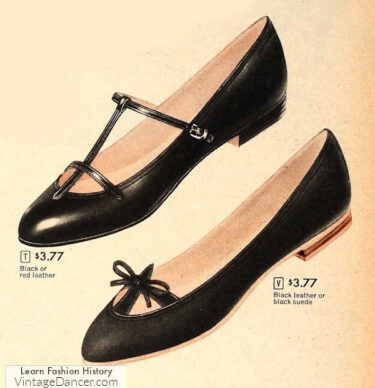
1959 two styles of T Strap flats
Another teenage shoe trend in the late ’50s was bunny shoes, or just bunnies. They were leather slip-ons in white, black or red with two “ears” for a tongue and wings on the heel for a bunny tail.
The fad for bunnies, also called pixies, was wide spread but short lived among girls and teens. Women’s shoes, however, adopted the “ears,” calling them twin peaks and placing them onto loafers and flats. The two peaks stayed in fashion into the early ’60s.
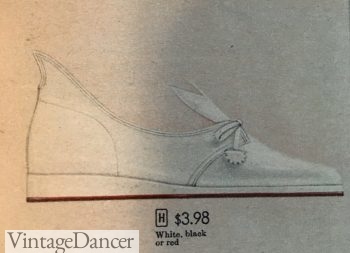
1957 Bunnies Shoes
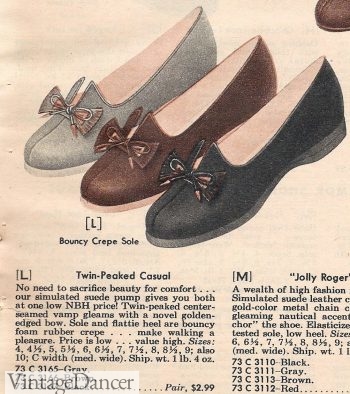
1957 Twin Peak Slip-on Shoes
1950s Loafers
The most casual shoe for girls and women was the loafer. Moccasins fit into this category and were a staple in most young women’s closets.
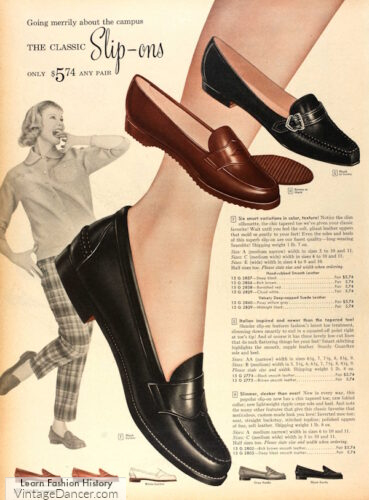
1958 loafer shoes
Easy to slip on, available in all sorts of fun colors, casual enough to wear with bobby socks or sockless, and durable enough to last all year, they were practically perfect.
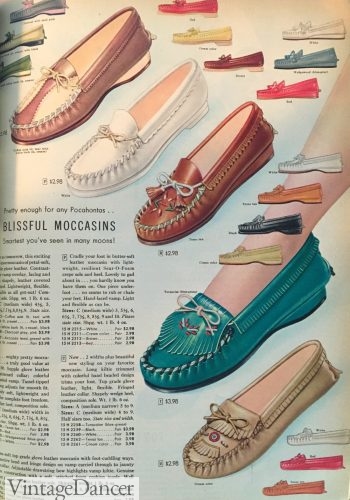
1956 Moccasin Shoes
The penny loafer got its name by the slit in the decorative leather strap across the tongue. It was sized for a coin that teens would use to call home. Brown or white were the most common penny loafer colors.
Other slip on loafer shoes came in many colorful shades and shiny materials, like patent leather or plastic. Some were clear plastic, although they proved problematic once the foot started to sweat, turning the plastic milky white. Yuck!
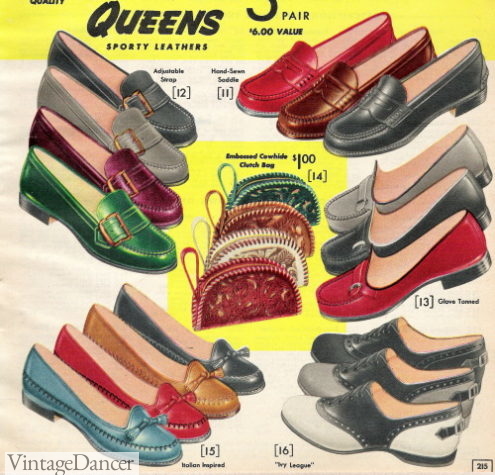
1957 loafers, flats and saddle shoes
Loafers were worn by women with sport attire, like play-suits, shorts, capri pants, and jumper dresses. Casual shoes for casual clothing was the rule. No stockings or even socks were required either.
All cotton cloth “washable” shoes were ideal in summer, without socks. Most casual 1950s shoes were ballet flats, loafer, slip-ons, sandals and sneakers.
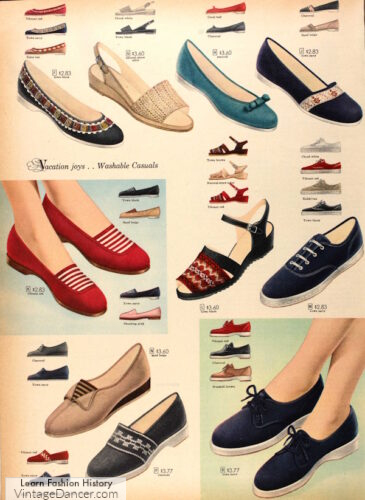
1957 washable cotton shoes
Women’s 1950s sneakers looked like classic Keds or low top Converse shoes in white, navy blue, light blue, beige or red. Many featured white contrast edging and a cork crepe rubber sole. These style of casual sneaker had gone unchanged since the 1930s.
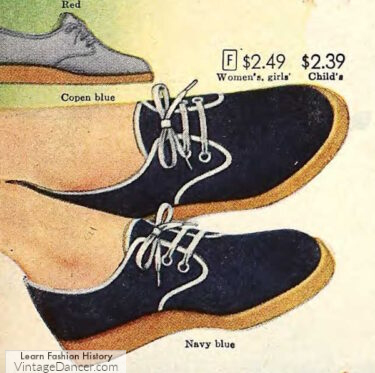
1953 crepe sole sneakers
Did they wear white sneakers in the 50s? The 1950s athletic sneaker for women and girls came in white high top or low top versions similar to Converse All Stars. These were worn for school gym classes and certain sports, rarely as casual footwear. Although black high tops were offered for men and women, they were not as trendy as white sneakers.
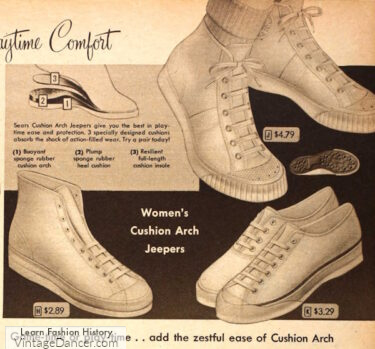
1952 sport sneakers- high top and low top
The classic Keds style of sneaker remained common as a gym, sport and tennis shoe. Toward the end of the decade they came in bright colors- red, navy blue, pink, aqua – crossing over into casual footwear. The 1960s would truly embrace the sneaker as a fashionable and fun shoe.
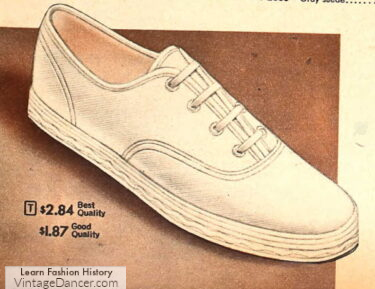
1959 casual sneaker shoes
Sneakers were not called sneakers in the 1950s. Instead tennis shoes were the general category or athletic shoes for the sporty types. Many brands promoted their own tennis shoes by brand name. There were Keds or Kedettes, Converse, Jeepers (Sears brand), Red Ball, P-F and others.
More about the history of women’s vintage sneakers.
1950s Sandals
The most casual of all sandals was the rubber sole flip flop. Women and girls loved them. Husbands, not so much. They were noisy to wear and many kids were only allowed to wear them outside, where they couldn’t be heard flip flopping away. They became very popular going into the 1960s.
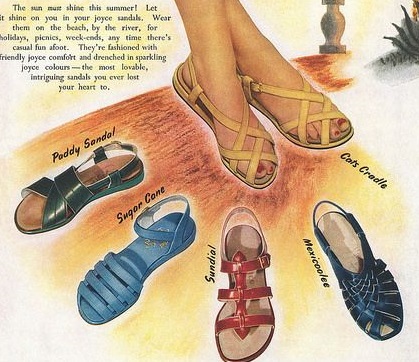
1951 Joyce sandals
Other common 1950s sandals were flats with multiple cross straps. Bright colors in leather, fabric, and straw made summer sandals fun to wear.
Take a look at the history of sandals through the decades.
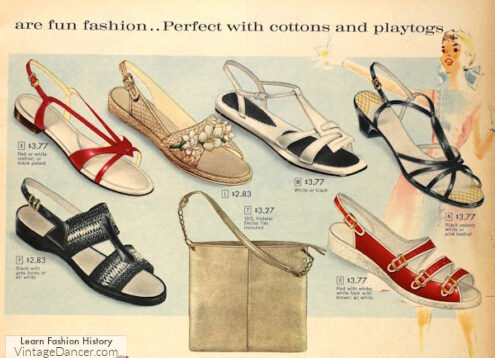
1959 thin strappy sandals
1950s Winter Boots
With high heels and casual flats dominating 1950s footwear, the question of how women dealt with rain and snow in winter is a common one. There were a few solutions, all depending on the severity of weather.
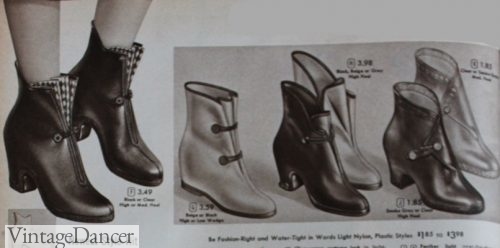
1950s rain boot covers
First, the rain. Rain boots or galoshes have gone unchanged since the start of the 1900s. The 1950s version offered up thin rubber boot covers that fastened to one side. They were worn over shoes, mimicking the shape of women’s high heels.
Another option was rubber slip-in heels or loafer that were worn instead of nice shoes (which were often carried and changed into once inside).
And finally, tall rubber rain boots like those you still see today were the ultimate in wet weather protection. Most ladies’ rain boots and shoes had a small to medium sized heel to keep a woman looking ladylike.
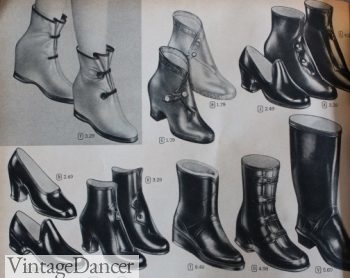
1955 Rain Boots and Shoes
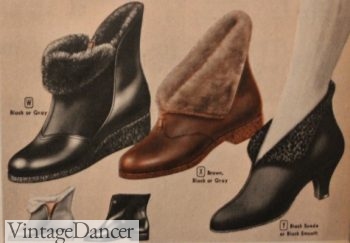
Fur Lined Boots and Booties
For snow conditions, a warmer boot was needed. Just like rain boots that were worn over heels, fur-lined snow boots also came in overshoes. There were shapely heeled boots as well as flat sole boots able to fit over Oxfords and other casual shoes.
The boots came in black, white, or brown leather or rubber with a zip up the front or fasted to one side. The zipper sometimes was packed in snow and froze shut. They were also not well known for there watertightness. Many mothers wrapped their kids’ feet in plastic bread bags before slipping them into boots. It worked, too!
Most lined boots could be folded over to create a cuff, or folded up to be a tall boot.
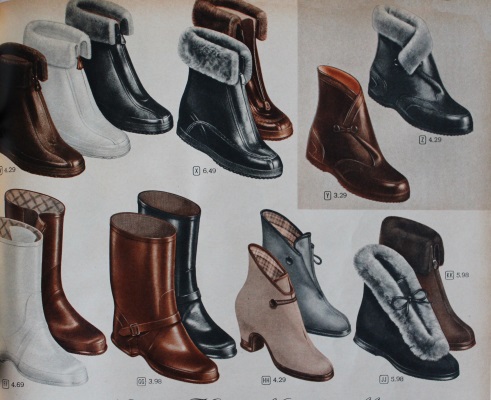
1955 Fur-lined Winter Boots
Winter snow boots and shoes came in other styles, too, such as tall lace ups, western, or ankle high booties. Lower priced boots replaced fur lining with quilting, shearling, faux shearling, or fleece.
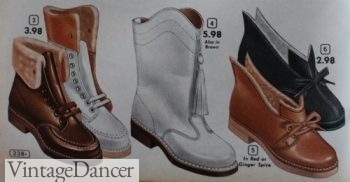
1953 Winter Fashion Boots
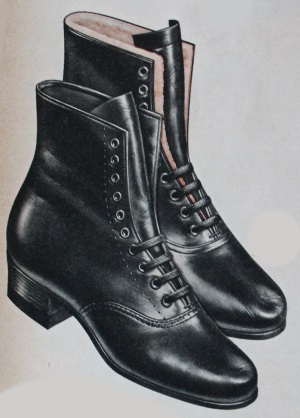
1955 Shearling-lined Lace Up Boot in a Classic “Victorian” Design.
Shop for vintage style rain boots and snow boots here and learn about the history of vintage winter boots with pictures here.
1950s Style Shoes for Sale
Many modern shoes have their roots in 1950s styles. A keen eye can find them almost anywhere.
- New, 1950s vintage style shoes – Out handpicked favorite shoes, boots, flats and heels in the 1950s style
- Wide shoes– Vintage style shoes in a wide fit (many are also narrow fit brands)
- Flats – Vintage style shoe with little or no heel
- Saddle shoes- Classic two tone saddle oxford shoes
- Sandals – Summer sandals in vintage styles
- Oxfords – Easy, classic, oxford shoes for all seasons
- Boots – Winter boots, dressy boots.
- Wedding Shoes- Wedding shoes for your perfect day
- Slippers – House slippers and lounge shoes
- Reproduction shoe brands– Where to buy vintage repro 1950s shoes.
More Vintage Shoe History
There are, of course, other styles of 1950s shoes not mentioned here. Sport shoes such as Keds or Plimsolls remained popular from the 1930s onward. Various boots for work or sport fashions are deserving of a future article of their own. Same for house slippers, sexy or practical. They were a part of every woman’s wardrobe, yet are not discussed in fashion history books very often.
If you don’t see a shoe style you want to know more about, leave a comment below and I will add in to the next 1950s Shoe Styles: Part Two article.
- 1920s Shoe Styles for women and Men
- 1930s Shoe Styles for women and Men
- 1940s Shoe Styles for women and Men
- 1950s Shoes for Men
- 1960s Shoe Styles for women
- History of Women’s Socks – 1920s to 1960s styles, colors and trends
Debbie Sessions has been teaching fashion history and helping people dress for vintage themed events since 2009. She has turned a hobby into VintageDancer.com with hundreds of well researched articles and hand picked links to vintage inspired clothing online. She aims to make dressing accurately (or not) an affordable option for all. Oh, and she dances too.
